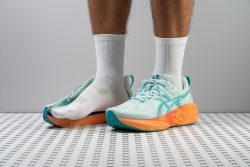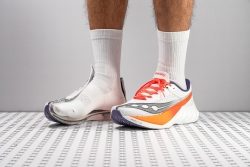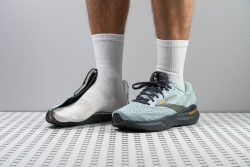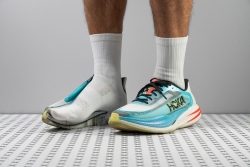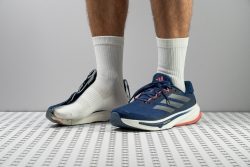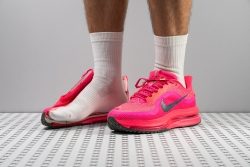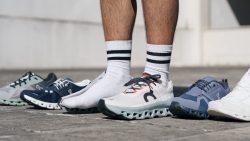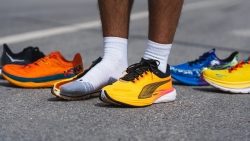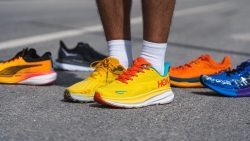7 Best Running Shoes For Heel Strike Pattern in 2025
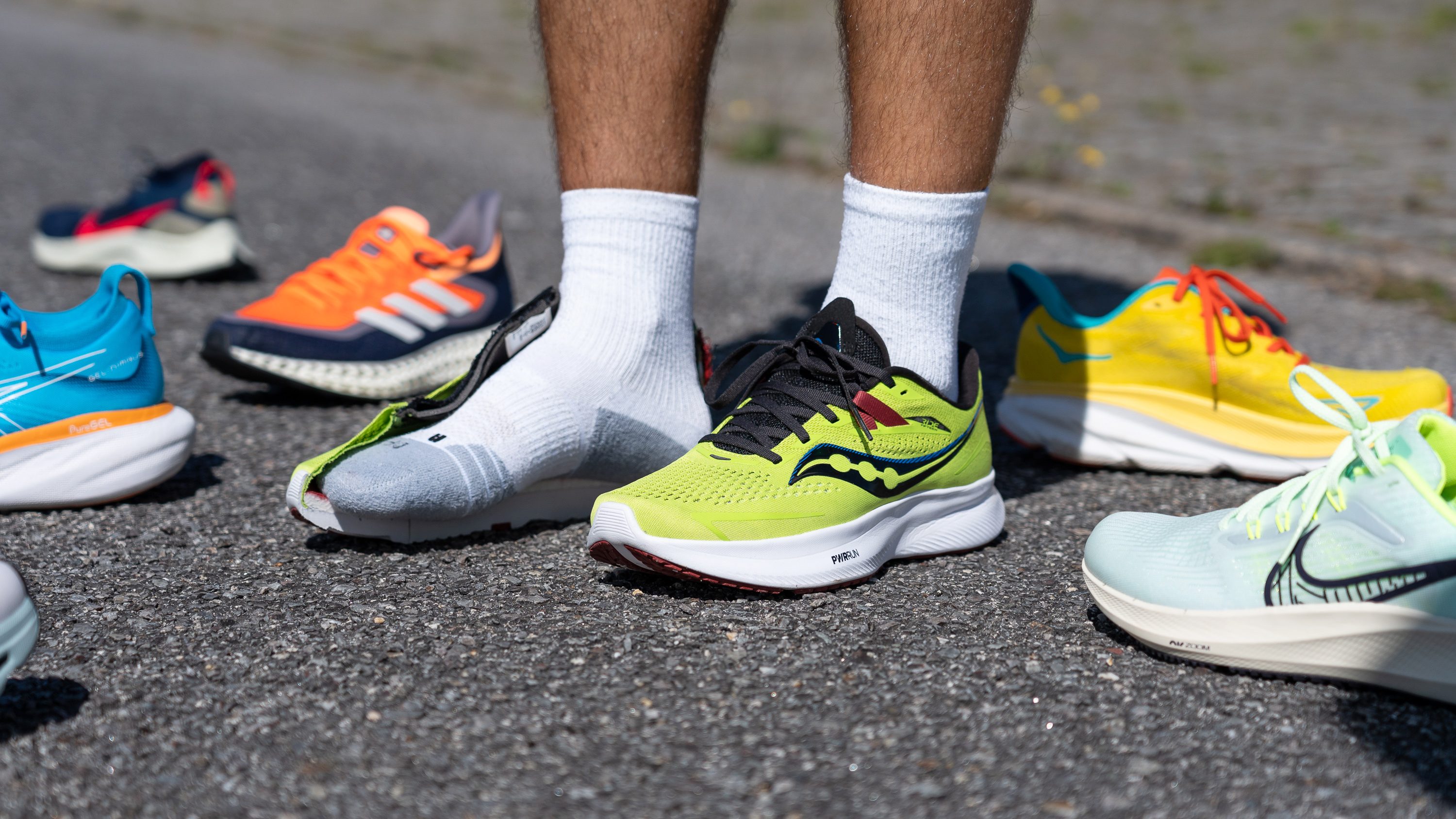
We buy shoes ourselves. We earn commissions when you buy through us, at no extra cost. Why trust us
Choosing the right running shoe for heel strikers can be quite tricky. It’s not just a question of which model has less or more cushion. It’s a combination of many things like drop, rearfoot support, the responsiveness of the foam, and impact protection.
The good news is you don’t have to go through all that because we already did! We ran in these running shoes in various routes and settings. We also took it up a notch and scrutinised the shoes in our lab. Here, you’ll find the best running shoes for heel strikers in different categories.
How we test running shoes for heel strike pattern
First, we purchase these running shoes with our own money. This allows us to publish unbiased reviews. We then:
- Conduct multiple runs in each pair. Our reviews are not about first impressions but getting a proper feel and understanding of the shoe's fit, ride, and durability.
- We cut the shoes open to see what’s inside. We delve deeper by checking the technologies and components of the shoes.
- We start with the basics and measure the stack heights, weight, and insole thickness, and move on to more complex tests like energy return, shock absorption, durability, breathability, and stiffness until we end up with 20+ data points.
- We publish all the results in our reviews and compare lab results to the averages for everyone to understand the context. We also make the shoes comparable by different features.
Best running shoes for heel strike overall
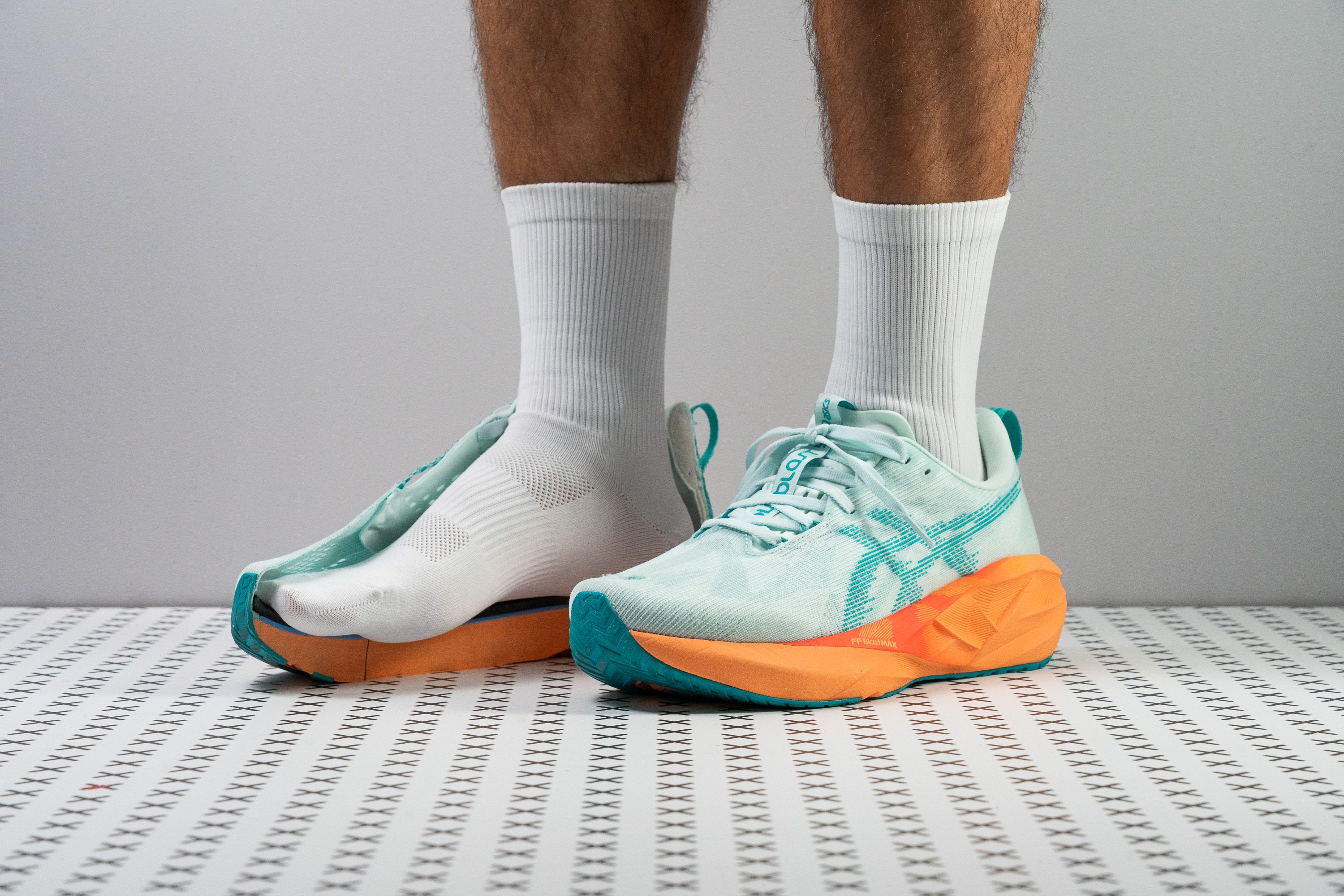























































What makes it the best?
We cut open the best heel-strike running shoes and learned that Novablast 5 is the best in the category. Its plush cushion supported every distance and pace we went for while burning daily mileage. Despite the visual bulk, it sustains a steady ride and maintains an effortless experience.
Novablast 5 delivers heavenly and cloud-like comfort. Each landing feels gentle, more notably on the heel since our calliper measured a towering 40.9 mm cushion. Our heels feel protected from surface impact. Upon checking with our durometer, the midsole emerged 38.4% softer than average, translating to a pillowy yet bouncy feel underfoot.
While most maximalists are unstable, Novablast 5 deviates from the standard by providing generous width to the midsole. It has an extra 8.3/6.9 mm in the forefoot and heel to find our footing securely without any ankle rolls. Even during sharp turns, our feet remain planted to the ground.
Novablast 5 is the perfect daily trainer because of its uncomplicated midsole and airy build. It moves naturally with our strides and is comfortable enough for walking. Our bend test confirms our observations when it measured 32.2% more flexible than average. And, our scales show it’s only 9.0 oz (254g)!
We warn caution that the outsole lacks traction for wet pavements. Those who need maximum grip should look elsewhere.
Pros
- Improved energy return with FF Blast MAX foam
- Plushiest foam in a Novablast yet
- Keeps the same price as v4
- Higher stack height for extra cushioning
- Enhanced flexibility
- Lighter than its predecessor
- Best Novablast ever for wide feet
- Exceptional weight-to-cushion balance
- Works for short, medium and long runs
Cons
- Breathability could be improved
- Toebox durability
- Toebox durability
Best daily running shoes for heel strike
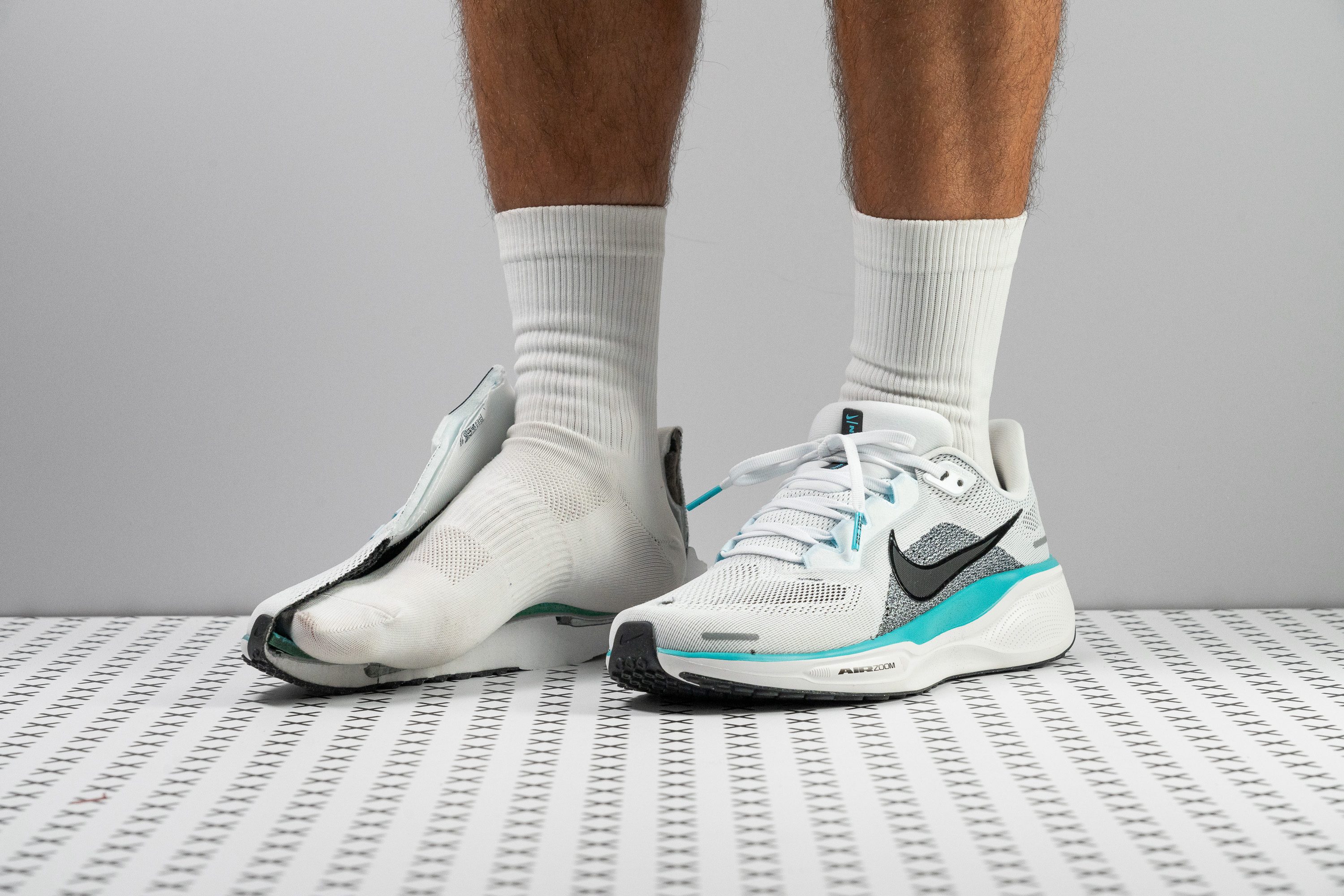




























































What makes it the best?
After running with the best heel-strike running shoes and dissecting them in the lab, we learned that Pegasus 41 is the ultimate daily trainer. It serves as a reliable partner for burning daily mileage with its natural yet steady ride, comfy yet responsive cushioning, and smooth transitions. From steady runs to LSDs to speed bursts, this Nike smashes them all.
Pegasus 41 promotes foot strength with its uncomplicated midsole. It moves naturally with our strides and feels effortless on foot, together with the curved sole that brings springier toe-offs. Our bend test confirms this emerging 34.0% more flexible than average.
Another standout feature is the new ReactX foam, which our calliper shows is 33.6/22.2 mm. It strikes a good balance between impact protection in the heel and surface feedback in the forefoot. With its high 11.4 mm drop, it's suitable for heel strikers. For added comfort, the foam is a plush 15.8 HA with two Air Zoom units elevating the experience.
The Peg also has subtle support elements, perfect for beginners or long-distance runners who need more guidance as their feet get tired. The midsole sidewalls prevent excessive movements, while the heel’s 89.2 mm landing area is wide enough to find our footing securely.
While Pegasus 41 is not overly heavy at 9.9 oz (281g), runners accustomed to lightweight shoes may feel it’s a drag.
Pros
- Enhanced for heel strikers
- New ReactX foam!
- Improved breathability
- Plush upper
- Good durability
- Several stability enhancements
- Newly designed rocker and bevel
- Solid performance
- Superior lockdown
- Sustainable features
Cons
- Price increased by $10
- Worse than the v40 in cold temperatures
- Poor grip
- Poor grip
Best race running shoes for heel strike
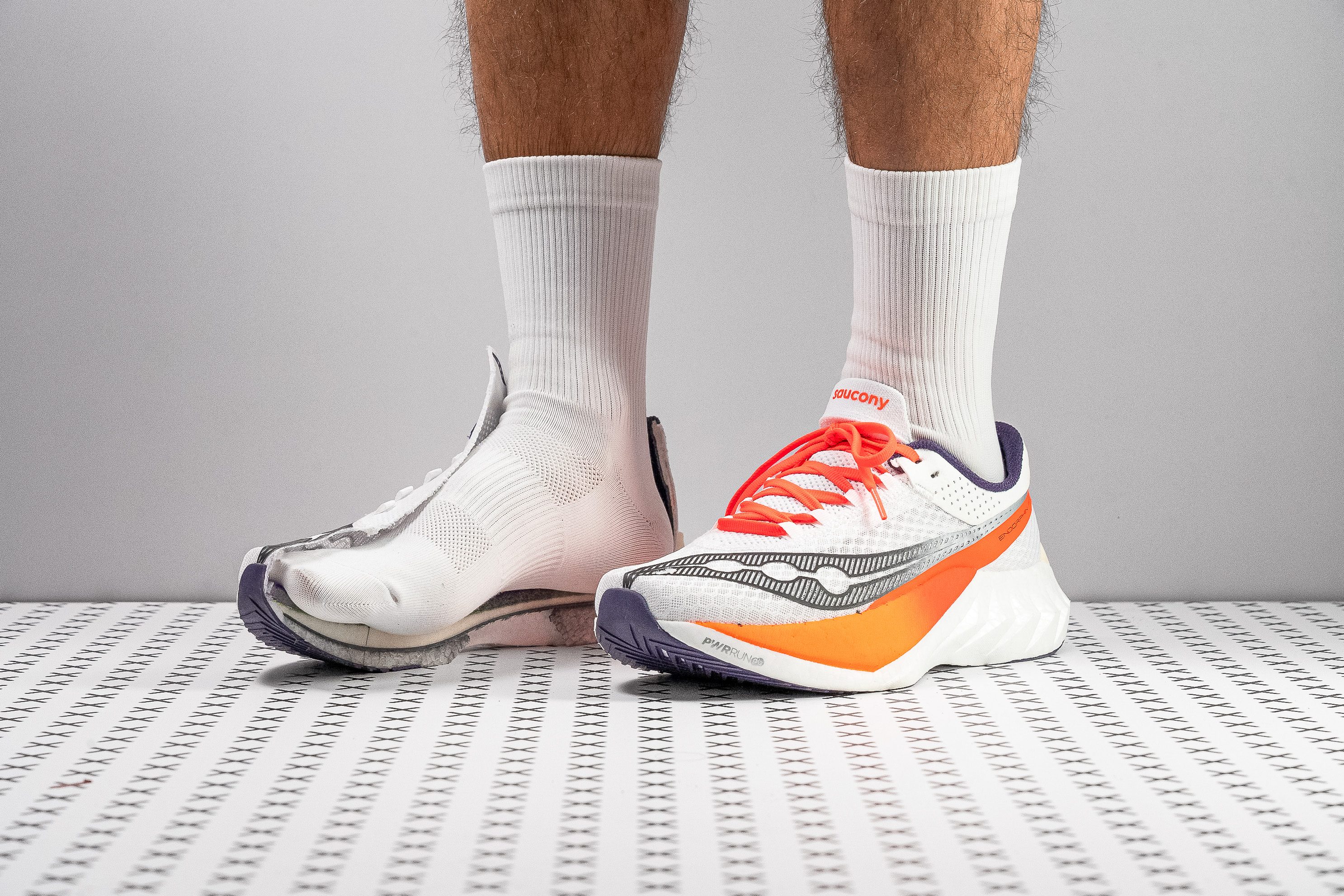


























































What makes it the best?
In terms of comfort and speed, the Endorphin Pro 4 is undefeatable. In our test runs, its plush and vibrant midsole is complemented by the carbon plate’s Speedroll technology, creating a smooth and energetic ride—definitely the heel-striker’s ultimate racing kick.
The lab and our own feet witnessed the magnificent power of this light supershoe. At only 7.8 oz (220g), it has so much energy to give that comes from the S-shaped carbon plate within the midsole, crafting an ultra-stiff core. We double-checked with our flex test and true enough, it emerged 137.5% stiffer than average.
Another energy source is the lively midsole that promotes effortless transitions without sacrificing comfort. Its plush 38.1 mm heel mutes out the ground with a 9.5 mm drop that supports heel-striker strides. Despite its stack, EP4 retains stability by incorporating a firmer 22.0 HA foam below the soft 18.5 HA top layer for steady support.
What’s even more impressive is the durable outsole that can survive repetitive landing impacts in the rear area. Our durometer reveals the 2.1 mm thick XT-900 rubber is a tough 85.3 HC. EP4 doesn’t stop there and performs better than average in our brutal Dremel test.
However, our experience tells us other elite racers feel faster since EP4 highlights comfort. Those who crave peak performance can explore other options.
Pros
- Durable upper and outsole
- Spacious upper fit
- Enhanced midsole comfort
- Great value at $225 for a supershoe
- Versatile across all paces
- Ideal for heel strikers
- More stable than ever
Cons
- Slightly heavier than v3
- Less suited for forefoot strikers
- Competitors may feel quicker
Best stability running shoes for heel strike



















































What makes it the best?
All our lab measurements and run observations prove the Brooks Adrenaline GTS 24 is perfectly matched for heel strikers in need of stability. It’s a comfortably cushioned shoe that positions gentle and rigid elements in the right areas to keep each landing secure.
The rear is where the magic happens in this shoe. We manually assessed the heel counter and awarded it a 4/5 stiffness rating, offering a steady hold without feeling too harsh. We also found the shoe to have a vast landing base in the heel, measuring 95.0 mm and exceeding the average by 4.3 mm.
In terms of comfort, the heel stack is a generous 39.0 mm vs. the 34.2 mm average, offering endless comfort for repetitive impact. Paired with a steep 13.5 mm drop, it smoothens our transitions and confirms this shoe is dedicated to rear strikers.
The GuideRails technology seals the deal as it extends along both sides of the shoe to embrace our feet in position. It almost felt impossible to lose our balance in this shoe.
However, the shoe feels slightly firm to boost support. Runners who prefer a more cushioned sensation should find an alternative.
Pros
- Stack height upgrade!
- Reliable support
- Breathable mesh with oversized vents
- Price remains unchanged
- Available in 4 width options
- Good durability
- Plush tongue for top comfort
- Ideal for heel strikers
- Foam upgrade to DNA Loft v3
Cons
- Firmer-than-expected midsole
- High drop may feel too steep
- Toebox height is a bit low
- Non-gusseted tongue
Heel-strike running shoes with the best shock absorption
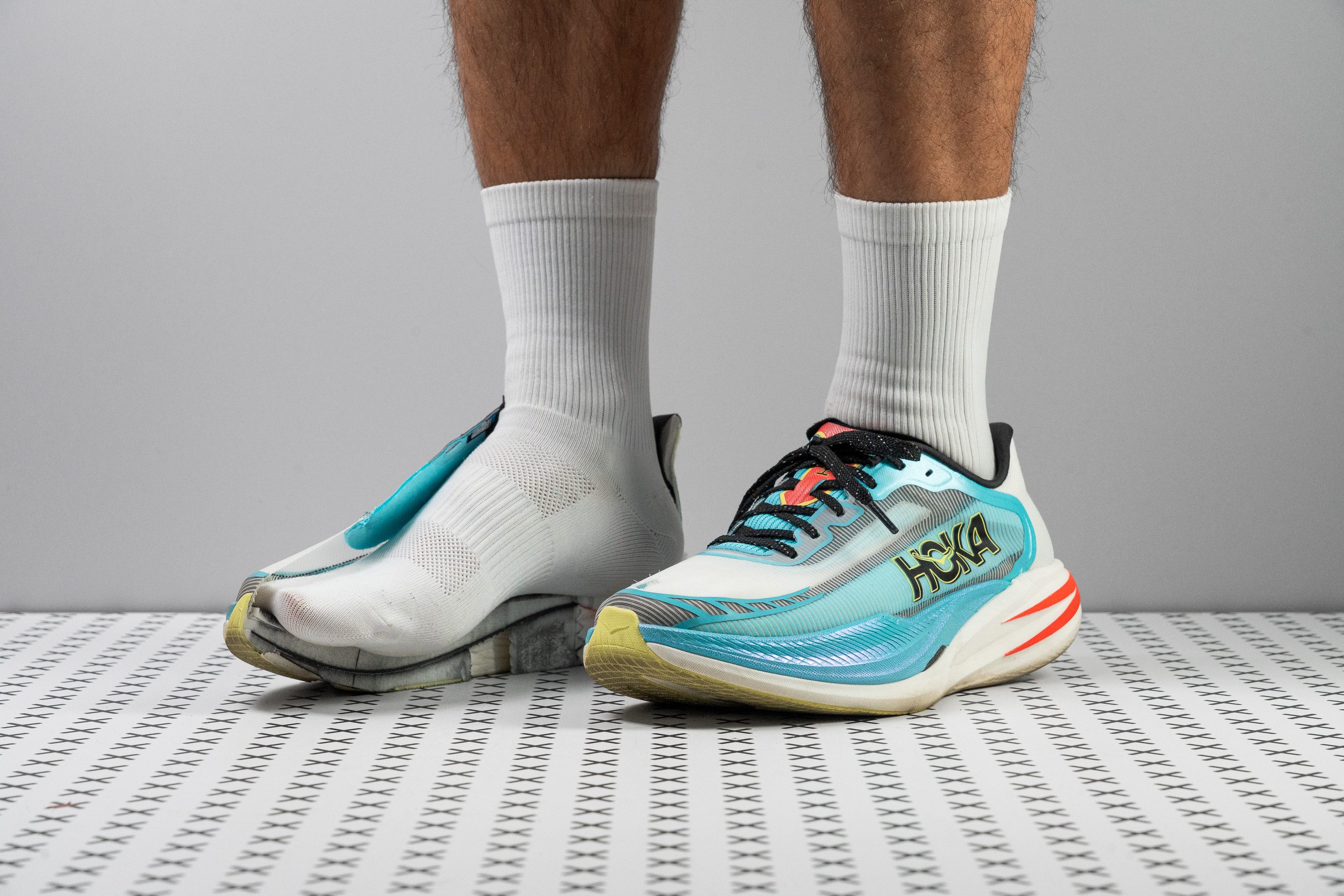

















































What makes it the best?
Slipping our feet in the Hoka Cielo X1 2.0 has a similar homey feeling to tucking ourselves in bed during landings, and a springy sensation wakes us with every toe-off. It’s all about exceptional comfort, sustained power, and an agile ride—making it our best shock-absorbing running shoe for heel-strikers.
Using our calliper, we measured the heel at 38.8 mm tall, effectively shielding our feet from impact. Not only that, we tested for its shock absorption, and it returned with a massive 160 SA reading, meaning it’s able to reduce stress on our legs by 26.0% more than average.
In terms of energy return, the heel impressed with a high 75.9% score, while the average is only at 58.3%. This result confirms the explosiveness we felt with every stride. In addition, the shoe features a carbon plate in the midsole and a bold heel curvature that drives us forward.
Another feature that boosts our speed is its light 7.3 oz (208g) build because it takes less effort to lift each foot and pick up the pace.
However, note that it’s not the most stable shoe out there. With a narrow 80.6 mm heel, we can’t recommend this pair to runners seeking extra support.
Pros
- Much lighter than v1
- Plush and responsive PEBA foam
- Top-tier breathability
- Forked plate adds heel flex
- Comfort-focused heel padding
- Outsole durability is not a concern
- Improved upper and laces
- Works well from 5K to the marathon
- Premium TPEE insole
Cons
- Pricier than most rivals
- Rocker can feel too aggressive
- Narrow-fitting upper
Best running shoes for heel strike and wide feet
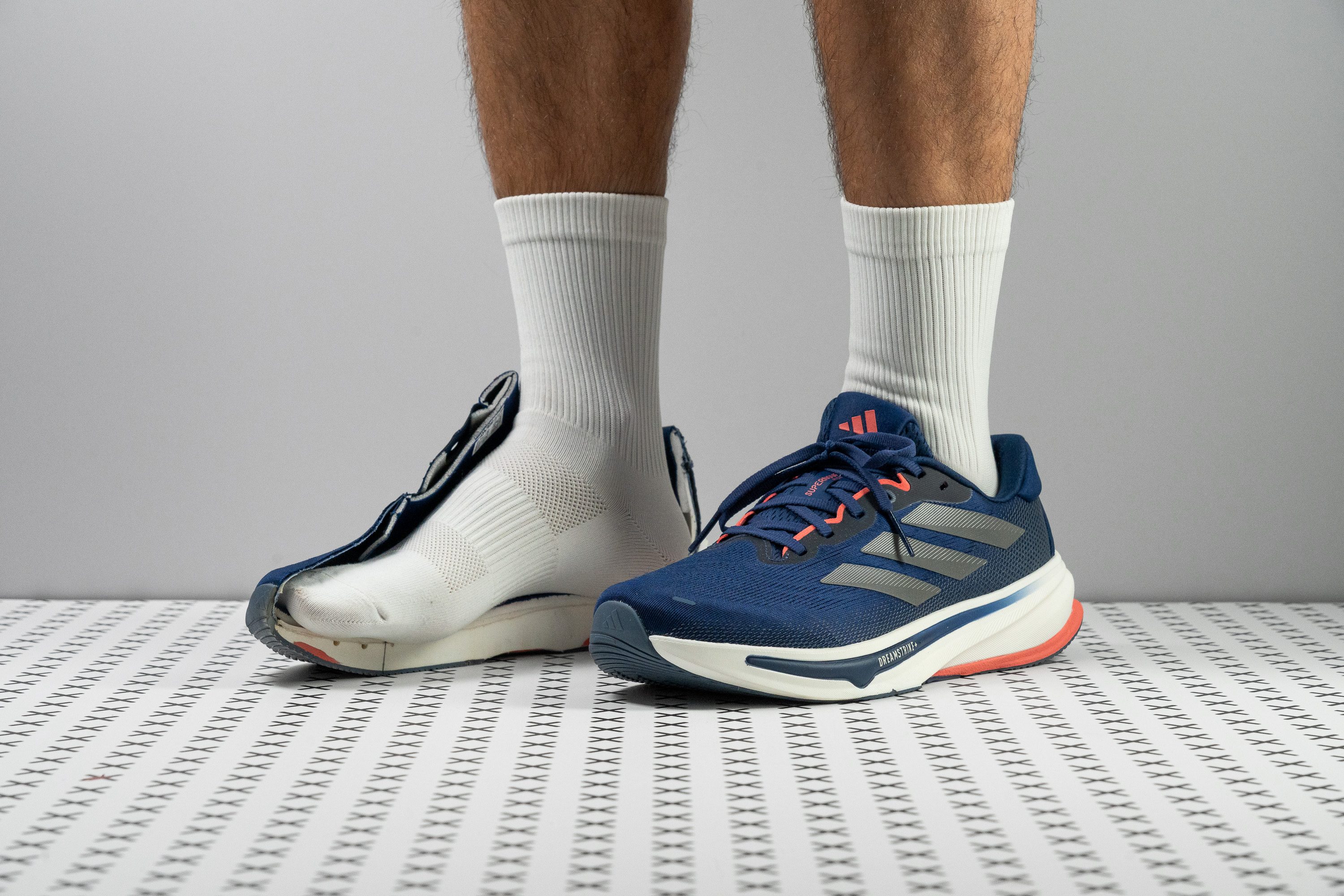

















































What makes it the best?
Utterly spacious, supportive, and easy on the feet—these are just some of the wonderful thoughts we had while testing the Adidas Supernova Rise 2 on the road and in the lab. With its forgiving ride and accommodating fit, we felt like we could log countless miles, making it the ideal choice for those with wide feet among heel-strike running shoes.
The shoe offers generous space for broad or swollen feet. Using our gel mould, we measured the ball of the foot area to be 98.7 mm, wider than the 95.5 mm average. We didn’t experience any unwanted pressure on our feet during testing.
The shoe offers a touch of stability through the small side wraps in the heel and the Support Rods, which work together to guide our foot alignment. And, it does so without compromising comfort! Using our durometer, we confirmed its well-balanced sensation through its 21.0 HA reading that is at par with average.
Its effortless sensation stems from its light and flexible build. Weighing only 9.1 oz (257g), it falls below the 9.4 oz (267g) average. Its low resistance adds to its airy sensation, emerging 37.4% more bendable than average in our flex test.
We believe the outsole has room for improvement, especially in terms of durability. Those seeking a long-lasting shoe should check alternatives.
Pros
- Lighter than version 1
- Comfortable yet breathable upper
- Cold-proof PEBA midsole
- Stable ride with Support Rods
- Reflective accents for night visibility
- Maintains competitive price tag
- Responsive Dreamstrike+ foam
- Flexible, natural running experience
- Great for walking
Cons
- Outsole lacks Continental
- Not cushioned for forefoot strikers
- Still lacks a gusseted tongue
Heel-strike running shoes with the best energy return
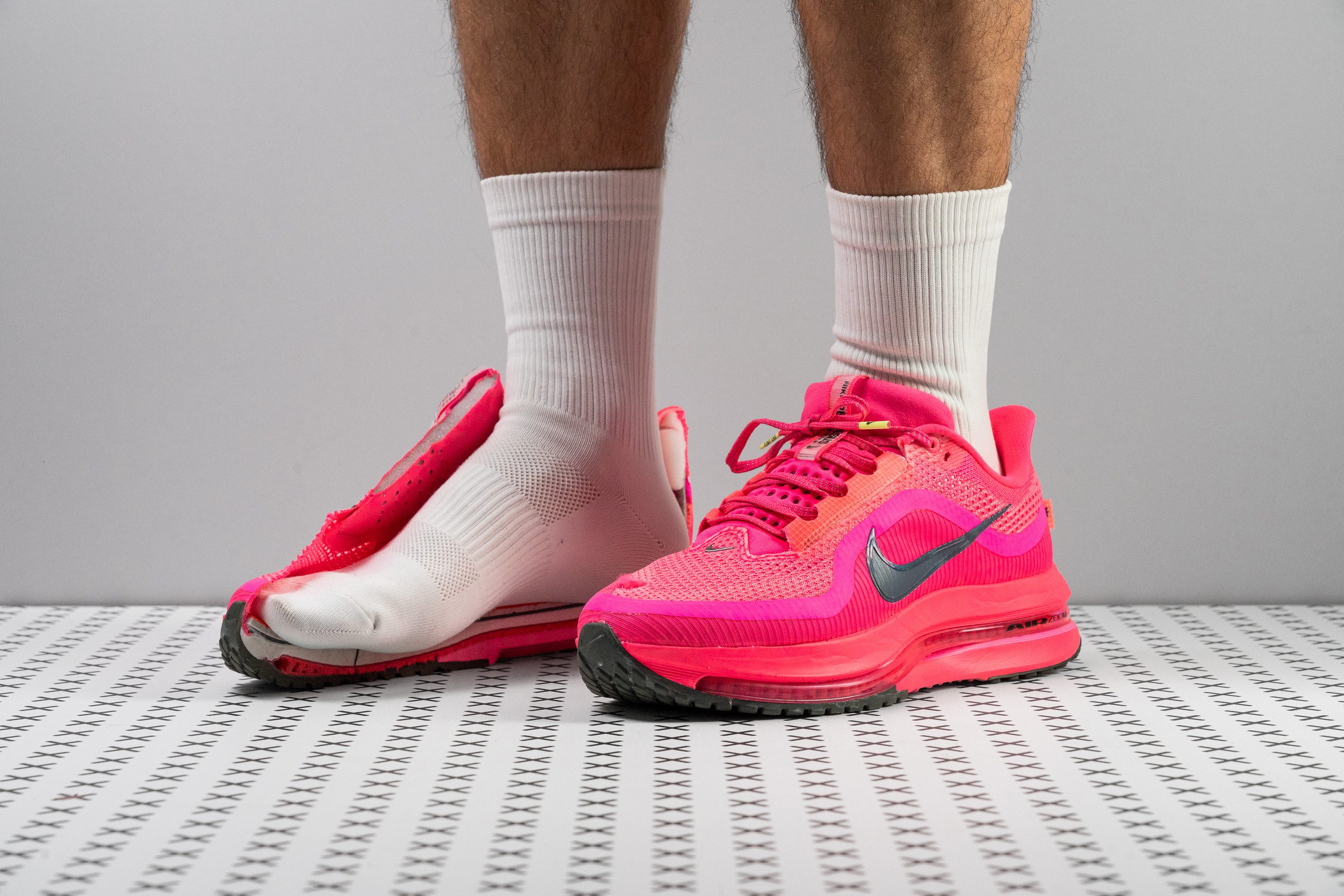




















































What makes it the best?
The Nike Pegasus Premium satisfied our craving for an adrenaline-filled ride, and we think it’s a great match for rear strikers because of its steep drop, excellent impact protection, and propulsive ride, which we confirmed in the lab. Yet what blew us away the most was its top-tier energy return among heel-strike running shoes.
The Pegasus Premium features a full-length Air Zoom unit that feels so good from heel to toe. Measuring the shoe’s energy return, we got a massive 67.3% score!
And with every powerful stride, plush landings await, proven by the heel’s high shock absorption score of 155 SA. For reference, it’s able to reduce impact by 22.0% better than average.
Its endless cushioning took care of our legs. Our calliper reveals a massive 42.8/31.0 mm stack, resulting in a steep 11.8 mm drop. At this level, it caters to smoother transitions for rear strikers.
Unfortunately, the tapered toebox may restrict runners whose feet are wide or prone to swelling. Those who want a more accommodating fit should try roomier alternatives.
Pros
- Triple-layer, spring-like midsole
- Handles long runs and tempo efforts
- Sublime step-in comfort
- Incredibly fun to ride
- Amazing build quality
- Knit upper offers top breathability
- Visually stunning from every angle
- 360-degree reflectivity
- Finally a max-cushioned Pegasus!
Cons
- Narrow fit excludes many runners
- Needs to lose some weight
- High price
- It's noisy!
5 things to look for in running shoes for heel strikers
Landing on the heel means we should focus on, obviously, the heel:
- How cushioned is it? Focus on the heel stack height. We recommend looking for at least 30mm at the heel.
- Good shock absorption so that the foam is protective enough for your feet and legs.
- Is the ride stable enough? Shoes that are too tall and narrow tend to result in unstable landings.
- Best to avoid the zero drop and low heel-to-toe drop. We recommend a heel drop of 8mm and above.
- Is there any outsole rubber at the heel? Some shoes meant for forefoot strikers tend to have rubber only at the forefoot. Getting these shoes would mean you would land on the exposed midsole, which would destroy the shoes sooner and would not offer enough protection and grip.
Caution: shoes to avoid if you’re a heel striker
Here are the shoes you should pay special attention to if you run into them:
- Carbon-plated running shoes aimed at forefoot strikers. Some running shoes with carbon-fibre plates work much better for forefoot strikers as they are able to properly activate the plate for the shoe to propel them forward. These shoes are clearly tagged as forefoot-strike only on our website and brands specify that as well.
- Minimalist and barefoot running shoes. These shoes don’t have enough cushioning and are very low to the ground. From our experience, it’s easier for forefoot- and mid-strikers to transition to minimalist and barefoot shoes, while heel strikers need way more time. Time asks for patience and without patience, you could end up injured.
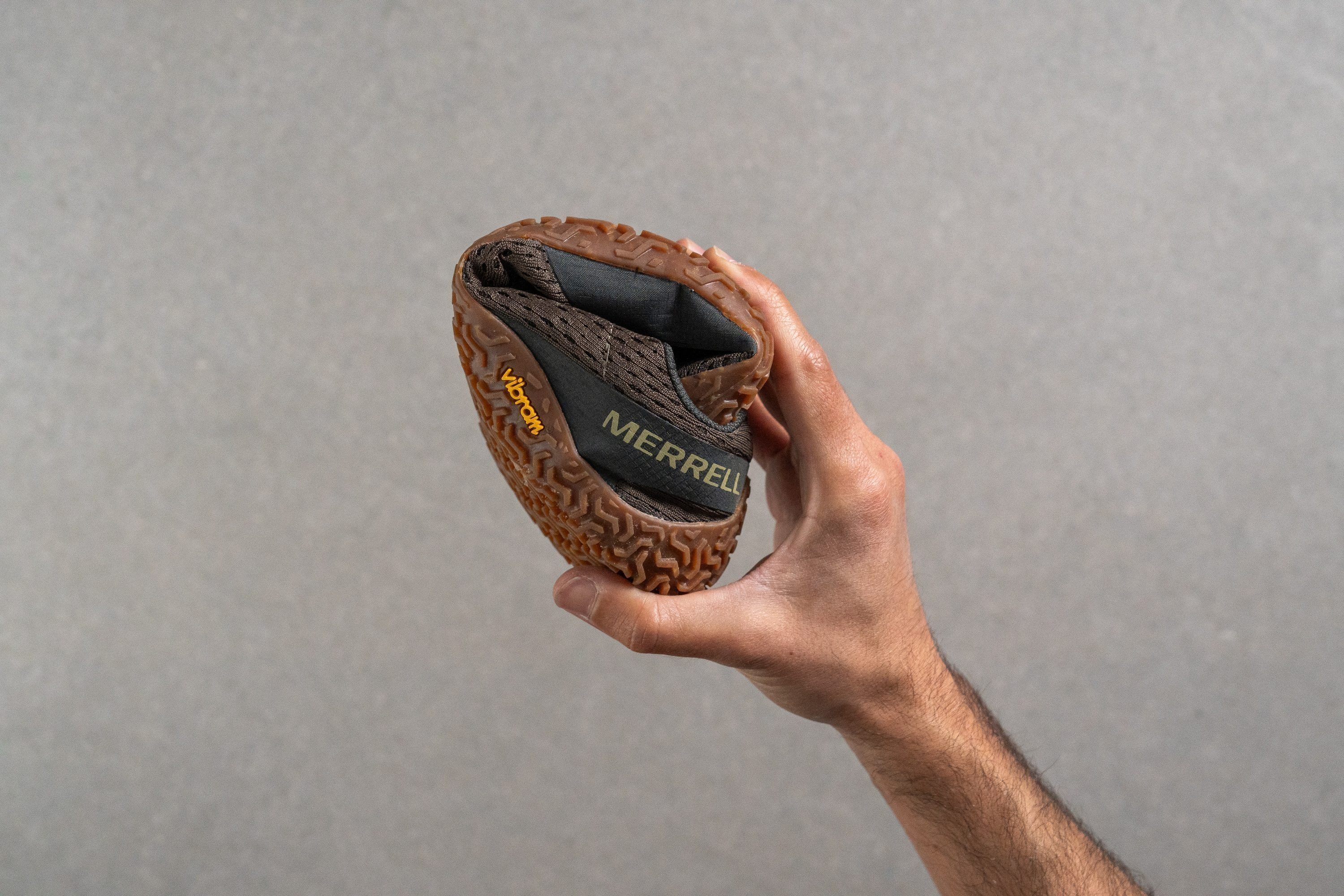
Is there enough foam?
Running shoes have to be cushioned enough to offer good impact protection. We focus on the heel stack height for heel strikers (just like we focus on the forefoot stack height for forefoot strikers).

Our recommendation is to look for at least 30 mm at the heel if you’re a heel striker.
Shock absorption of running shoes for heel strikers
Every time we hit the gound at the landing, we do so with an impact of 2-3x our body weight, or even more when heel striking or doing so at a fast pace. These forces are harsh and we need something to absorb them so that our legs experience significantly less stress. This is exactly what a midsole does and it's called shock absorption.
When shock absorption is low, the midsole is not dampening the impact very well, and our legs experience this as premature fatigue or sometimes even foot pain (depending on how low the shock absorption actually is).
In running shoes, anything below 110 SA is considered low shock absorption; up to 130 SA it is moderate, and higher than 130 SA is high or great.
Stable ride is a priority
First, if you’re overpronating and need stabilising technology that reduces the inward roll of the ankle, you should look for stability running shoes. These shoes feature trademarked stability technologies or geometrical technologies that help with overpronation.
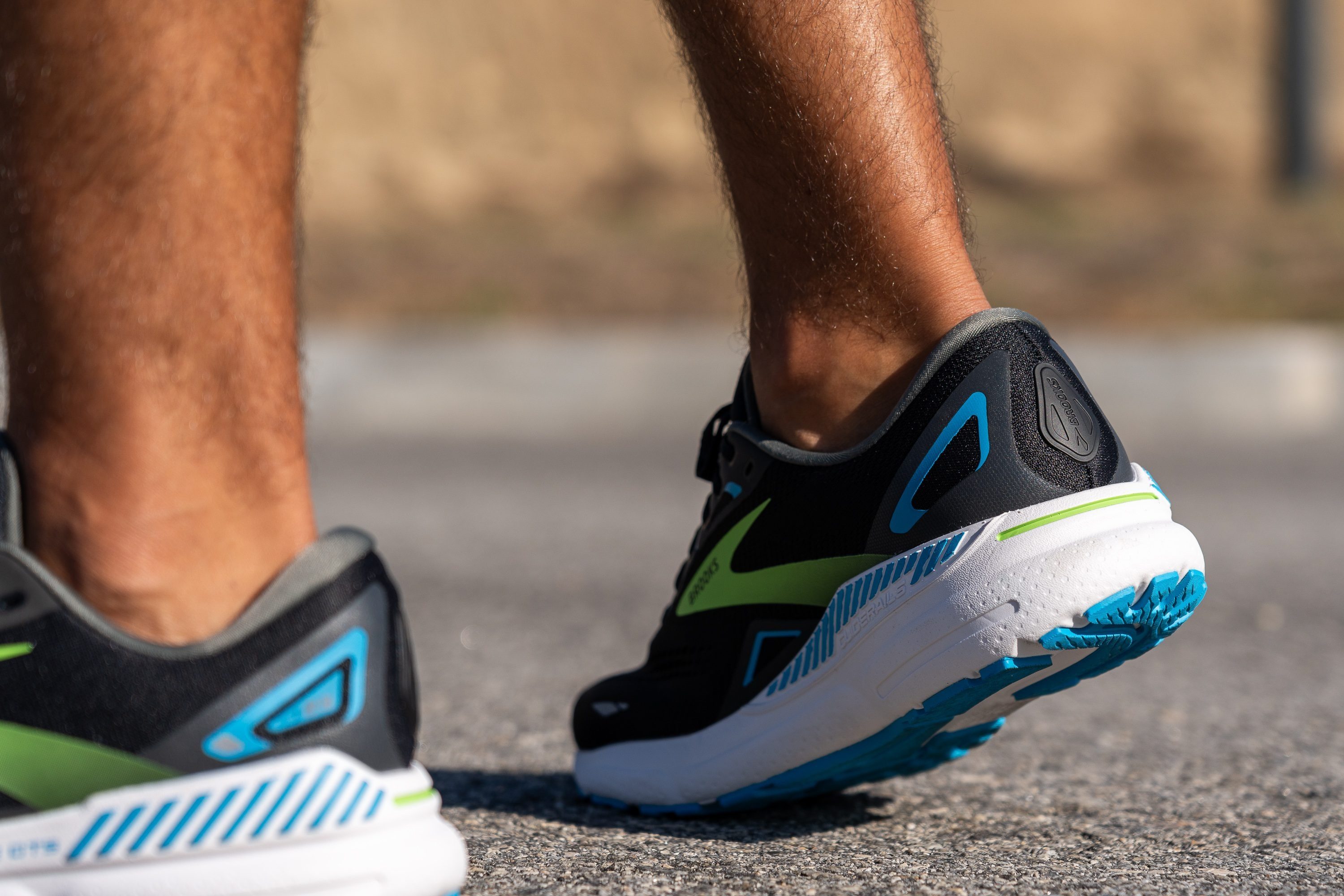
Second, you might be a neutral pronator or a supinator (read more about pronation here) and simply want a stable ride. The stable ride is usually found in shoes that are not tall and narrow, but that have a wider base.

To check this, we measure the stack height as shown in the section above, but we also measure the width of the base. We use a digital calliper to measure the width at the forefoot and at the heel, but given that you’re heel striking, we will prioritise the heel numbers.
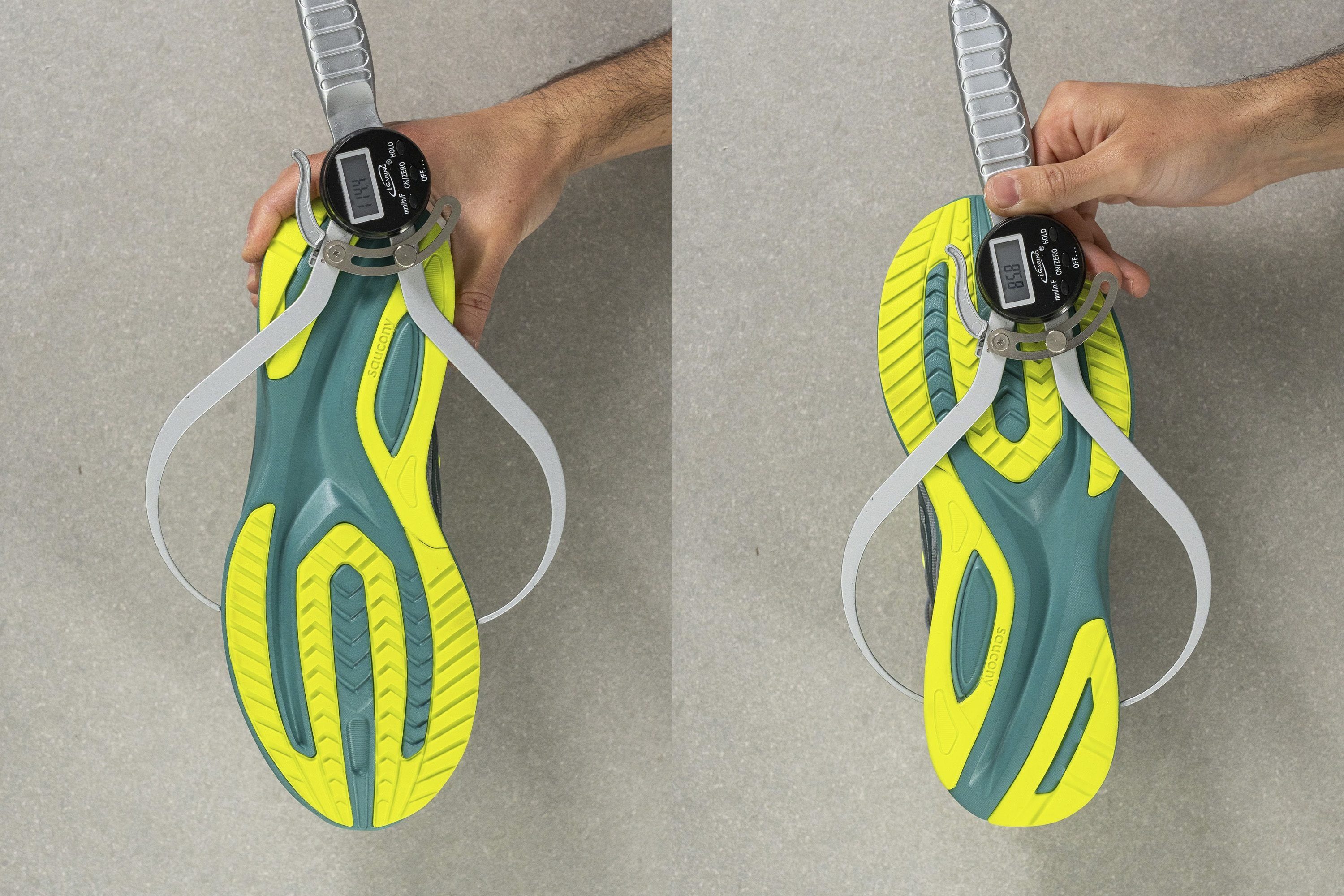
The wider the base, the more stable the landing.
Avoid zero and low drop if you’re a heel striker
We recommend that heel strikers avoid zero drop and low heel drop. At least avoid them if you’re a beginner and not knowledgeable yet about the heel drop, the different muscles it can utilise, and potential shoe rotation combinations that could help you strengthen your feet and legs. This is quite an advanced approach.
Heel drop is the difference in height between the heel and the forefoot. It goes from 0mm to 16mm. The most common recommendation for beginners is to choose shoes with a heel drop of 8-12mm. 10mm is a non-written shoe standard.
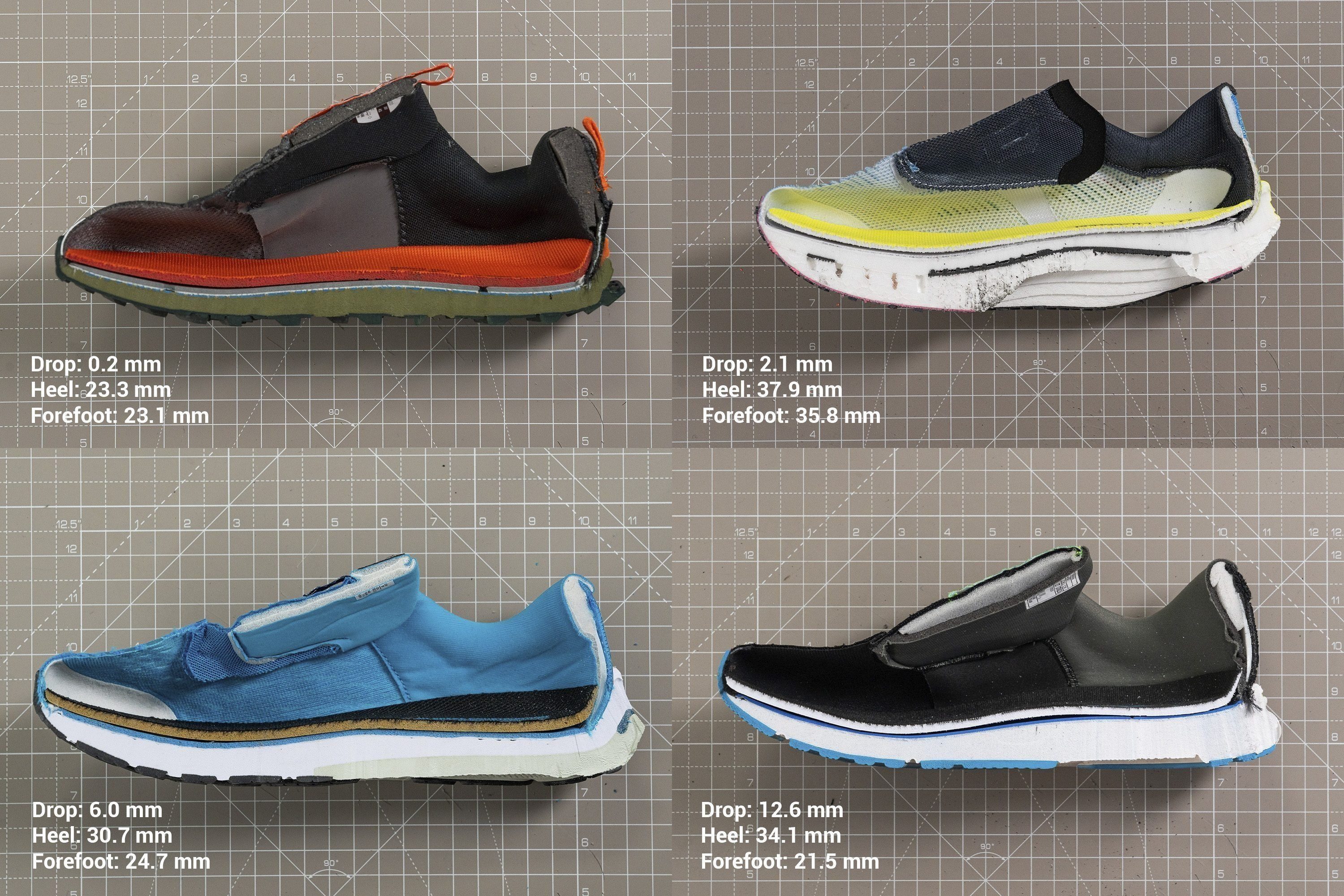
The trouble with lower drop is that:
- It uses lower leg muscles and zero drop uses the foot muscles the most. This change asks for a very gradual transition which can last for months
- Lower drop usually means lower height at the heel and we want the heel to be high off the ground for proper impact protection
- Runners tend to change to forefoot strike when running in shoes with zero drop or low drop and that change can be too much for some runners, especially when not done gradually.
Look for outsole rubber at the heel
Some running shoes are meant for forefoot strikers and we see that because the rubber on the bottom is placed only at the forefoot or forefoot and midfoot.
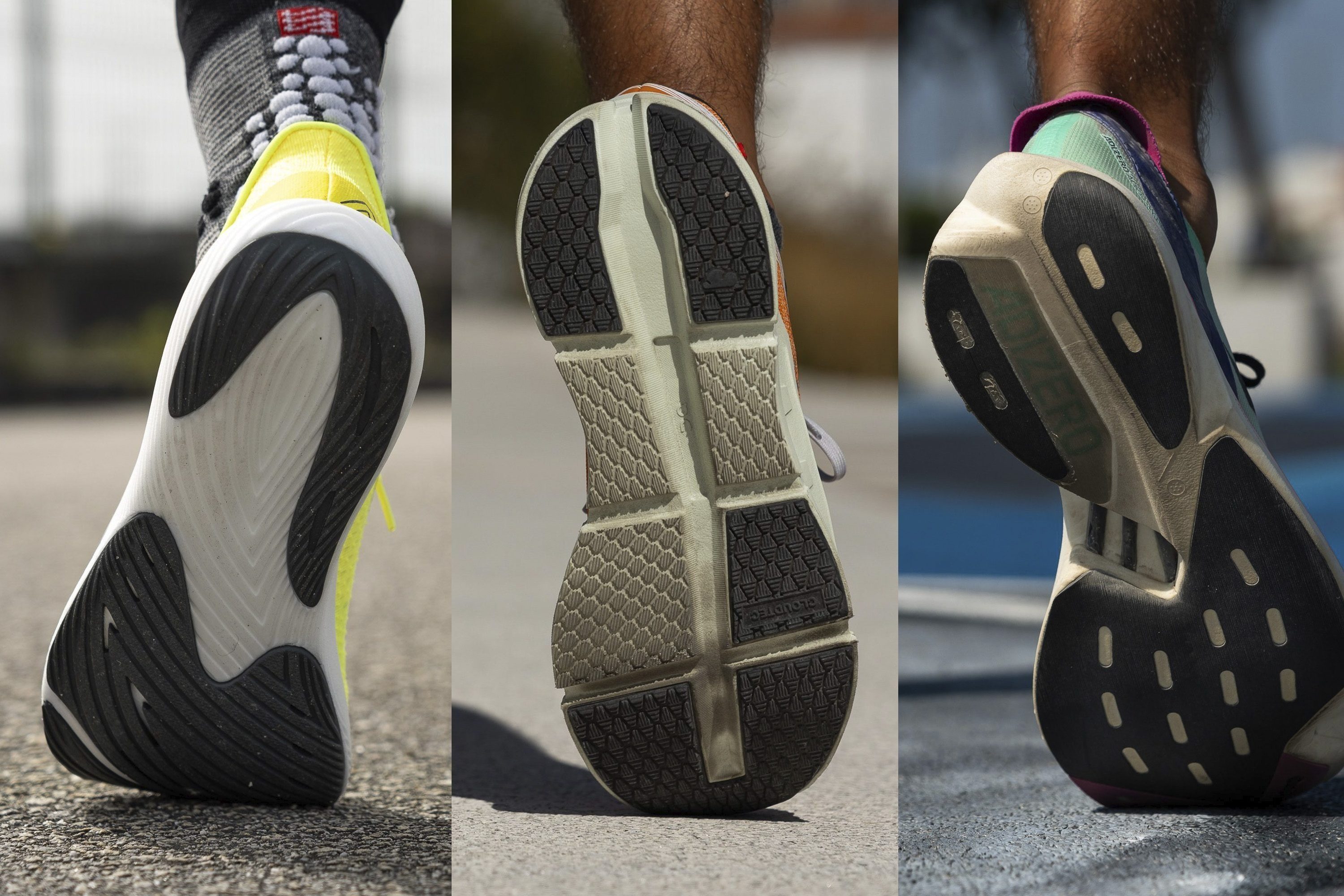
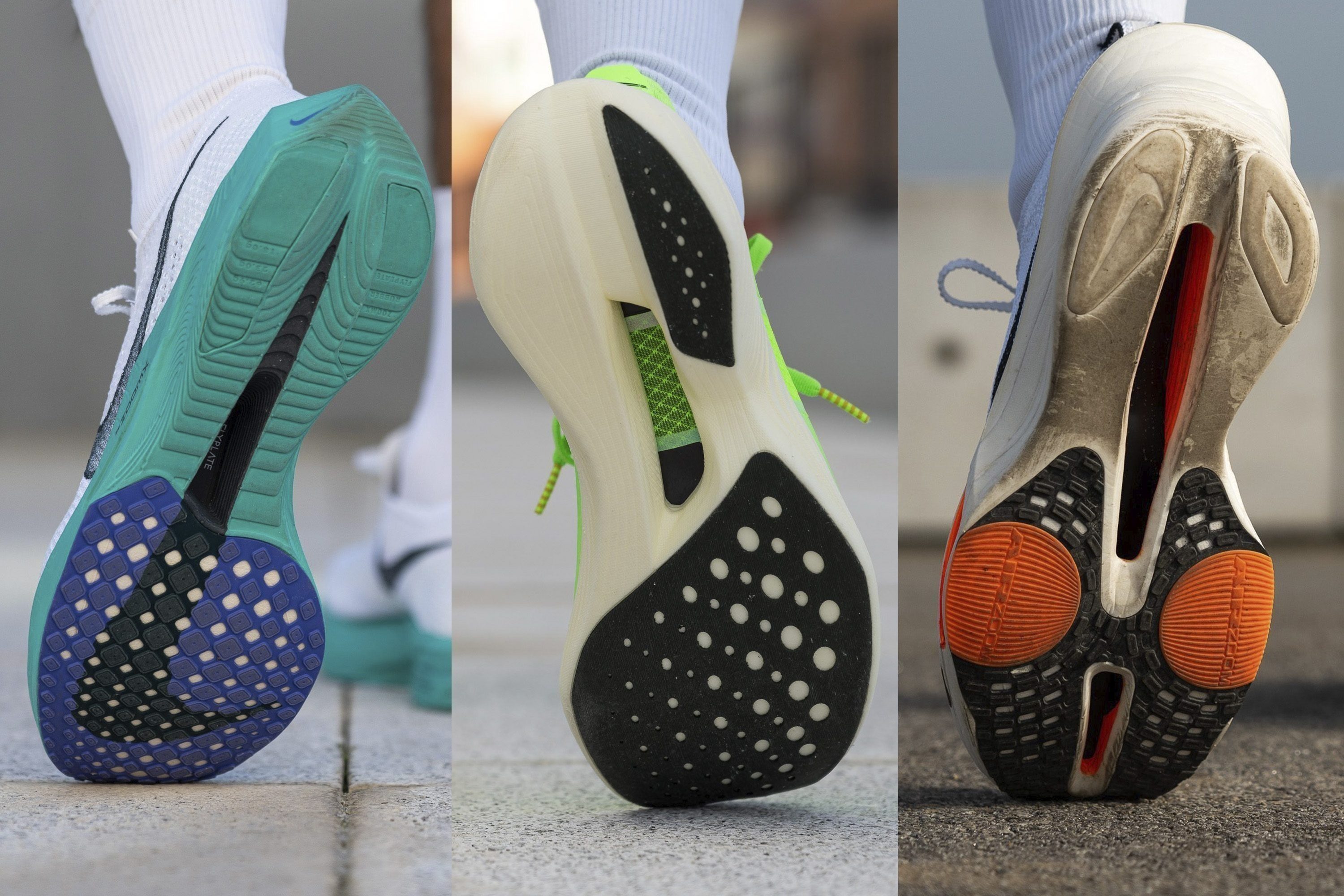
Heel strikers can run in these shoes but should know that the exposed midsole offers no grip in wet weather, plus the non-rubber outsole is destroyed way sooner than the rubber.
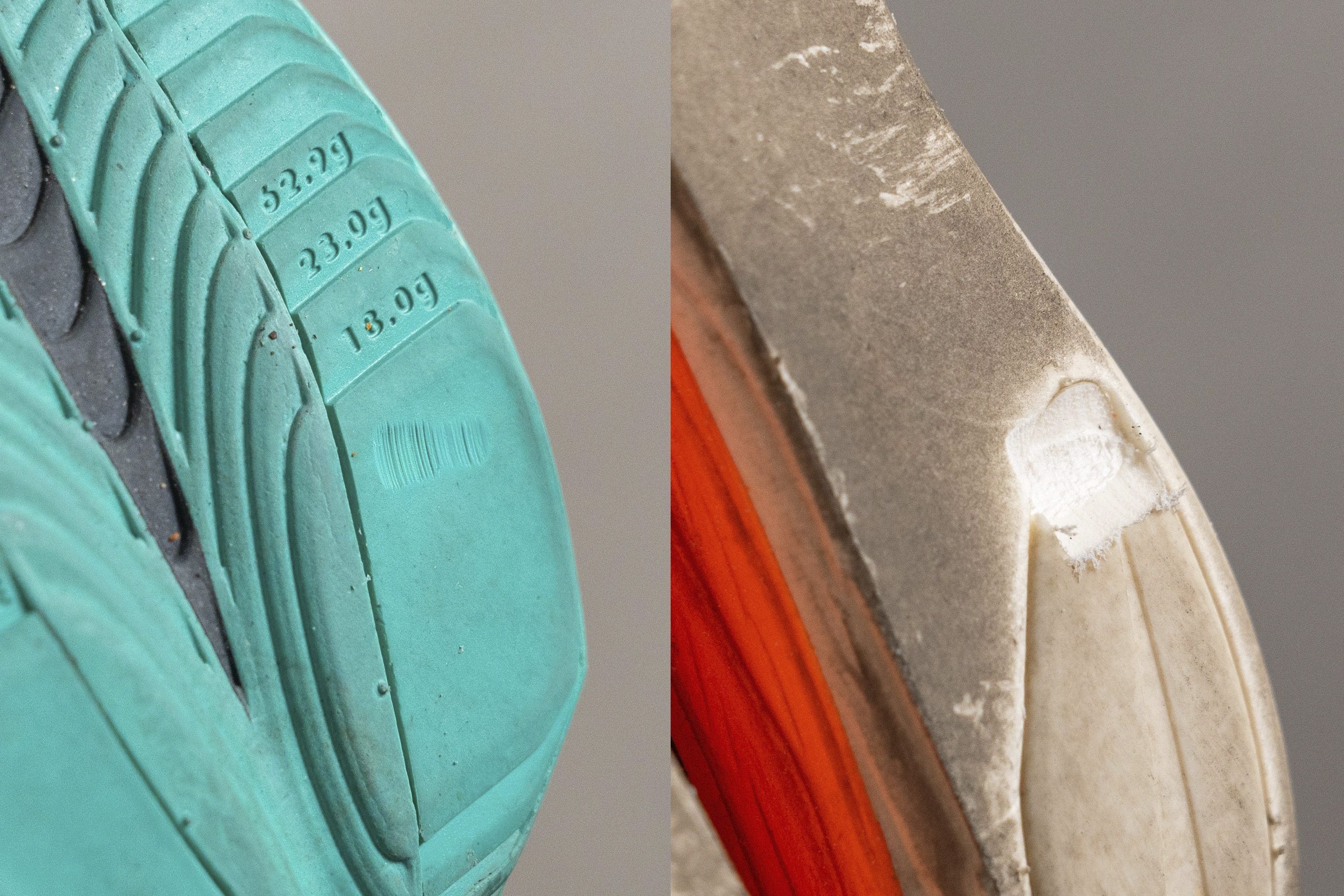
How we know this? From our experience and from our durability lab test. We press a dremel against the outsole, always at the same RPMs, pressure and duration.
We measure the depth of the dent with a tyre tread gauge. The deeper the dent, the less durable the outsole. Knowing this, you can look for the most durable outsoles found in running shoes for heel strikers.

